Everyone Bad
“According to a study by Symantec, 96 percent of people who picked up the lost phones tried to access personal or business data on the device. In 45 percent of cases, people tried to access the corporate email client on the device.”
The Goldman Sachs Op-Ed

Everyone online is sort of sniffing at the already-infamous “Why I’m Leaving Goldman Sachs” op-ed in today’s Times, and much of that sniffing is understandable. Lots of people definitely know, assume or simply believe that Goldman has been for much of the last decade (or longer) in the service of steering their clients wrong in favor of profits. This is a totally reasonable (and valid!) conclusion, after all, after the activity of the last five years. (Particularly for anyone who saw their incredibly terrible returns on investment after ill-timed BRIC-chasing and plenty of other recession-era disasters.) And so their point is: well, what were you doing, Greg Smith, staying there for so long while it all apparently went so wrong? What were you doing to steer the culture away from being bad advisors and pigs?
That reaction has… some truth to it. Some of these scoffers are not wrong. Goldman, meanwhile, is doing its part to undermine him. But all the scoffing overlooks a few facts.
When Greg Smith writes about the culture of Goldman — “teamwork, integrity, a spirit of humility” — those are not just empty words. They sound funny from the outside, sure! But “the Goldman way” was drilled into employees and executives in a way that likely has no other workplace equal in intensity outside of perhaps the Marines or the Symbionese Liberation Army. Being self-effacing; saying “we”; sharing credit; posting your working group on developments: people who bucked this process were beaten down until they conformed.
This culture — which also highly valued do-gooding and public service, or at least the ideas of such — is pretty much just brainwashing. (Not bad brainwashing particularly! But all the same.) That state prevents employees from realizing that Goldman’s history of making money at any cost might have always been a part of the culture of the firm.
And you can see how he’s internalized this brainwashing.
I think he truly believes, based on his 2nd paragraph, that if GC serves the interests of their client, they are serving the world. #koolaid
— Judd Greenstein (@juddgreenstein) March 14, 2012
While people in media and other fields are constantly flouncing out and making dramatic pronouncements about the evils of their former employers, breaking publicly with the firm is so completely outside the boundaries of what’s conceivable that this deserves a little more respect that it’s getting. (Although, true too: it would have been nice if he’d been a bit more specific. For him, these are bomb-throwing words; for us, it’s hard to cut through his op-ed to find the meat of the matter. There’s not so much there beside his actual declaration of being betrayed, right?)
Biggest reaction I’m getting from people outside of $GS: “Did Smith just notice that $GS has a corrupt culture?”
— John Carney (@carney) March 14, 2012
Still, the criticism also overlooks the departure agreements and the like: the contractual leg of the deep culture of privacy. When people depart the firm — willingly or unwillingly — the enormous agreements, obviously, forbid people from speaking about the firm. (In fact, the termination agreements for layoffs said that former employees would forego any promised compensation not just if they spoke about the firm in any way but would forego payments in a number of other circumstances, including just being charged with a crime.) While I’m sure Smith isn’t in the slightest hurting for money, he is now considered the ultimate traitor.
This is a firm that researches its opponents as deeply as any mafia. This is a firm that thinks nothing of sending a former programmer to jail because he was trying to back up some opensource software and included chunks of what the firm considered proprietary software; they stopped at nothing to ruin him along the way. This is a firm that’s been nearshoring in Utah for years, so as to capture a highly immobile and not coincidentally highly moral worker population. This is a firm that got vast, disgusting concessions from the City of New York because they pretended they were going to move out of downtown — and then, even after receiving them, expanded their New Jersey headcount, due to more concessions on the other side of the river. This is a firm that practices surveillance-level research on its negotiation counterparties, and has no qualms about bringing their information and forensics to bear in negotiations.
While many of us feel like this is just another tardy confirmation of what we all already knew — which, well, it is! — this is still incredibly damaging for the firm. Goldman’s reputation right now is, rather deservedly, fairly terrible. Anyone who’s previously worked there who’s brought up their former employer in public has been, over the last two years, subject to actual face-to-face scorn. (Which is probably for the best! Society should shame those who damage it!)
Traders and hedgies are reading Greg Smith’s Dear Goldman letter in utter confusion. “Wait. You mean those things are wrong?”
— Epicurean Dealmaker (@EpicureanDeal) March 14, 2012
But the venue of the Times gives rich people — actual Goldman clients, who don’t read Rolling Stone, or our stupid blogs and snippy Twitter accounts — something to have their assistants print out. They’ll actually read this, and they have phones on their private planes to call their friends.
Meanwhile, the Internet will do what it does best.
The “Greg Smith as hero” narrative will shift over to the “Counterintuitive takedowns of Greg Smith” narrative by the end of the day.
— Hamilton Nolan (@hamiltonnolan) March 14, 2012
GoogaMooga Great No Matter How You Spell It
“A report last Wednesday in the Off the Menu column rendered incorrectly the name of a food and music festival planned for Prospect Park, Brooklyn, in May. It is The Great GoogaMooga, not The Great Googa Mooga.”
Jona Lewie Is 65
https://www.youtube.com/watch?v=62eTq8ErUOQ
The amazing — and criminally obscure (at least in this country; his fellow Britons of a certain age are probably still unable to get “Stop the Cavalry” out of their heads) — Jona Lewie turns 65 today. Here’s a good place to start. I’m partial to “I’ll Get By In Pittsburgh,” but, really, you can’t go wrong.
How To Make Veggie And Chicken Stock
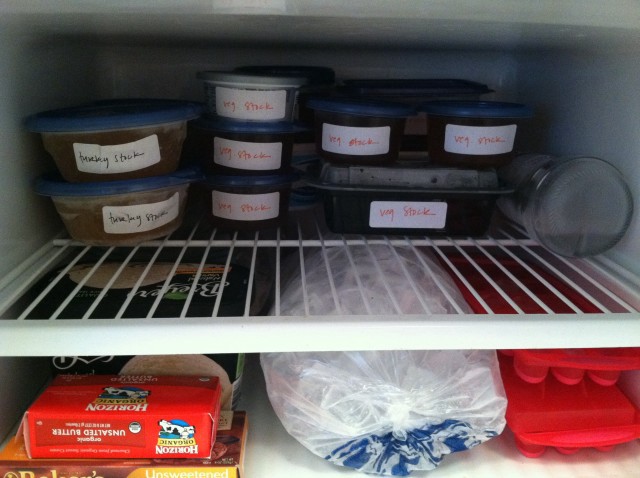
You probably know you should be making stock. It’s easy and basically free and so much better than the canned or boxed junk you buy at the store, and it’s a thing you need in so many recipes, like perhaps the ones you’ve been enjoying in the Deep Dish kickasserole series! Those are all great reasons, and we haven’t even gotten to the smug-factor that comes with being able to say that you’re a person who makes her own stock.
But probably you aren’t making stock? Even though it’s easy. And smug-making. Because — and here maybe you should sort of huddle around me so the stock-making evangelists among us can’t hear — while it’s easy, it’s not exactly convenient: it simmers a long time so you’re stuck at home for that, and the straining process is kind of a pain in the ass, or maybe, like me, you live in a tiny urban skycave with an economy-sized freezer and you have no room to store the stuff. Does any of that sound familiar? Still, if you’re A Person Who Cooks, you should try making stock at least once, just to say you’ve done it.
The instructions here are for vegetable stock and chicken/turkey stock. Beef stock? Covered that already. Fish stock? You’re out of your mind if you think I’m going to boil fish parts in my home for four hours. But to make up for my absolute refusal to speak to you on the topic of fish stock, I will tell you how to roast a chicken. Generous, right?
Storage And The Urban Skycave Dweller
We’ll actually start at the end of the stock-making process and talk about storing stuff first. You’re going to need a million (rough count) small freezer-safe storage containers, because these recipes make 19 cups of stock or something insane like that and you’ll want to portion these out into 1- to 2-cup servings for later use. Which is great news for all of you empty-Parkay-container hoarders out there! You can also do the pour-stock-into-ice-cube-trays trick but while that sounds so genius, it’s actually a GIANT hassle.
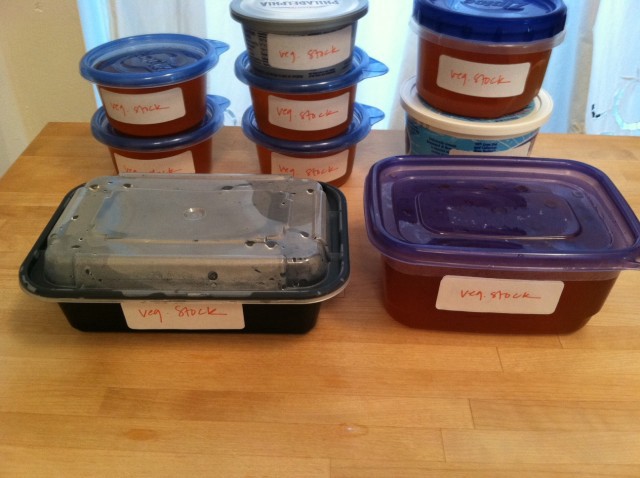
Now then, those things have been discussed before in other places and they’re not insurmountable. But there’s something else, something really important that we need to talk about here and will do because we are your friends and this is what friends do, tell each other the hard truth about life: that stock? Is awfully judge-y and hoooo boy does it ever have a mouth on it. Every time you open that icebox there it is, hissing at you, “Use me. Uuuuuuuuuse meeeeeeeeeee. You wretched ingrate, I am delicious homemade stock, use meeeeee. And call your mother.” It’s really terrible. As a wise man once put it, in response to my attempts to foist off containers of turkey and beef stock because I was drowning in the stuff, “I never make stock anymore because yup, freezer, full, sad, angry.”
With pesky logistics out of the way, we can talk about the basics of making the stuff, which boils (heh) down to: throw a bunch of garbage in a big pot, cover with water, bring to a boil then simmer for some hours, strain, store and done. But the devil is in the details and who’s more fun than the devil, right? So let’s talk details.
Veggie Stock
There are two main approaches to veg stock, which I refer to as The Three Root Vegetable Approach versus The Scrap Approach. In the first, you’ll take carrots, celery and onions and boil them in water for about an hour, then strain and store. Garlic, mushrooms, tomatoes and/or peppercorns make nice inclusions to the T.R.V.A. Would you feel more comfortable if I gave you some measurements? Because I can do that! So let’s say something like:
2 onions
2 celery stalks
2 carrots
1 cup tomatoes
1 cup mushrooms
2–3 cloves of garlic
10 or so whole peppercorns
6–8 cups water
Roughly chop your veg, throw them into a large stockpot and cover with cold water. Start with cold water, by the way. There are reasons for that but do you care what they are? I thought not. Just start with the water cold and save your questioning for the things that matter in life, like why there isn’t a picture of an awl on The Awl. Bring the whole mess up to a boil and then drop it to a simmer. Simmer for an hour or so. Keep an eye on the heat level — you want to keep it at an even simmer throughout, even if it means turning the heat off entirely for a few minutes to let the stock cool its jets.
If you want to get really advanced with things — though honestly? don’t — you can brown the veggies before you get them into the water and/or chop them rather finely, as there are those who insist that one or both of those techniques produce more flavorful stock. I believe them! I just truly don’t give enough of a fig about producing more flavorful stock to bother.
The second method, or The Scraps Approach, is just that: boil/simmer up whatever you’ve got lazing around in your vegetable drawer and/or any scraps you’ve saved. Which brings me to The Saving of The Scraps and how I’m an asshole who has a giant Ziploc in my freezer (for this I have room?) that I trot out every time I cook so I can dump in the carrot peelings or the onion ends or the kale stalks or whatever. Once the bag of trash is full up, the contents go into the stockpot along with some peppercorns and garlic cloves and we’re off to the races. I’m being completely serious here, by the way, both about this practice and about the fact that it makes me the worst person ever. Also we refer to it as “the bag of trash Jolie keeps in the freezer because she is the worst.” When I grow up, I’ll probably turn out to be the sort of woman who makes homemade baby food. Don’t worry though, I hate myself so you don’t have to.
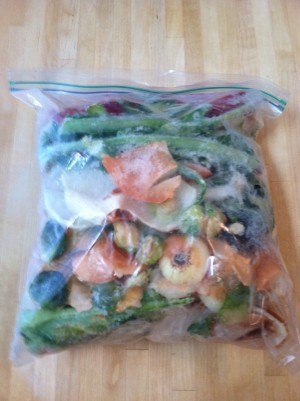

Once your stock is done simmering, you’ll need to strain it before storing for later use. But first let it cool for a while. I use a splatter guard placed over the top of my pot to hold the mess o’ scraps back while I pour the liquid out into a large bowl, but you can use a traditional colander placed over a bowl.
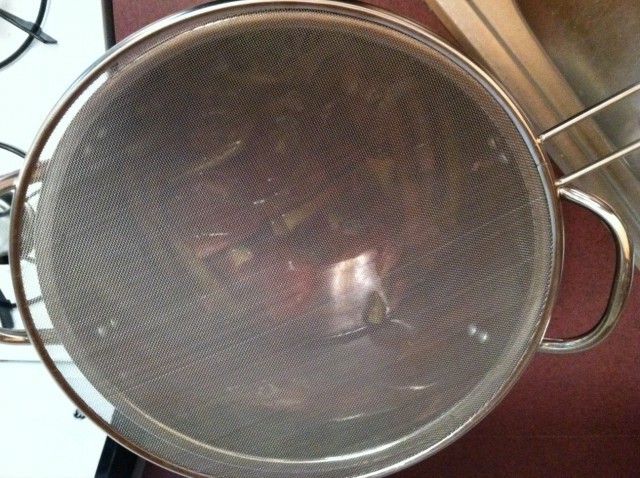
The best best best thing to do if you’ve got the equipment, is to use a pasta insert to hold all the veggies, which can then be pulled out of the pot leaving only the pristine stock ready to go into your storage containers.
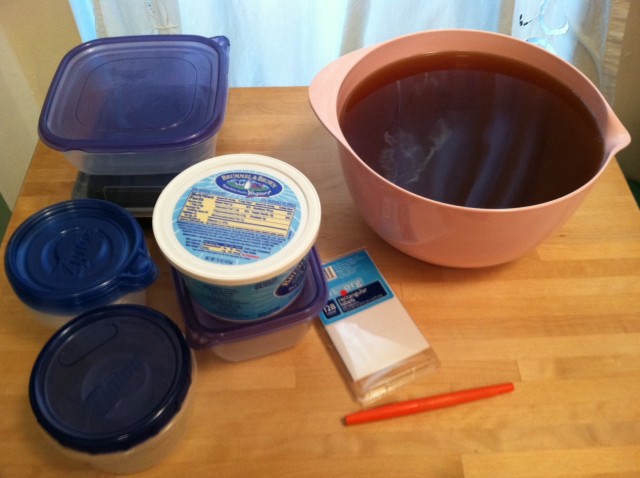
How To Make A Roast Chicken, Then Turn It Into Chicken Stock
The same straining and storing instructions apply to chicken and turkey stock, which is what you’ll make when you have a carcass left over from Thanksgiving or from that awesome roast chicken you made when you had friends over the other night.
Oh wait! Has anyone ever told you how to roast a chicken? Because it’s stupid easy and really cheap and so yummy and a great thing to serve when you’re having people over for a casual dinner. Serve it with a starch, a veg and/or a simple salad and prepare to be a hero to your friends. This is my go-to method, though of course there are a million variations.
Buy a whole chicken. Also buy a lemon, a big one. Or two small ones. And if don’t already have it at home, some dried rosemary and garlic salt; before the anti-garlic salt people come for me: this is probably the only thing I ever use garlic salt for, because it just does something to the skin that I can’t resist. Then you’ll get out a big baking dish; some simple ceramic or metal thing will be fine. Slice the lemon in half. Leave one half intact and cut the other into rounds. Let’s say four of them.
Take the bird out of his packaging and throw that mess away. Including the stuff in the inside of him, which is a little gross but won’t hurt you, it’s in a tidy bag. (Maybe try not to look at it too much though, okay? Okay!) Rinse Mr. Bird in cold water and then pat him dry. No, Adrienne, do not use soap.
Put the chicken in the roasting pan, breast-side up. Oh, at this point you should have the oven coming up to temperature — 375° will do it.
Using your fingers, separate the skin from the chicken’s flesh. Yes, I know. But you have to. Okay, now take the slices of lemon and slide them under the skin. It will feel like you’re going to second base with the bird and that’s okay. Take the other half of the lemon and stick it in Mr. Bird’s third base.
Now sprinkle him with a bunch of garlic salt and rosemary, and then massage it in. Basically, molest the bird.
Bid Mr. Bird fare-thee-well and put him in the oven. Leave him in there for an hour and a half. Maybe peek in and baste him a bit if you’re feeling curious about how he’s doing. After an hour and a half, check in on him and if his skin looks nice and brown and like he could pass for a cast member on “Jersey Shore” he’s probably done. If not give him 15–30 more minutes. Et voila! A roasted chickie.
Once you’ve eaten everything off Mr. Bird that you’re planning to eat, put his carcass in your large stockpot along with some of those nice aromatics we’ve talked so much about. An onion, a few carrots, some celery, garlic cloves and the like. Toss in a handful of peppercorns. Do not add salt. We don’t add salt to our stock; we add it to the dishes we use the stock in. This is very important to know.
Cover the whole mess with cold water and bring it up to a boil, then drop to a simmer just the way you did with the veg stock. At this point you can play Choose Your Own Adventure: if you’ve got four hours to spare (“Housewives” marathon, anyone?), go on and let the stock simmer on the stovetop before removing from heat, cooling, straining and storing. If you don’t have four hours to laze about the house get out of my face, you overachiever. Ha ha, just kidding! (Not really.) You can shorten the active cooking time by using the “steeping” trick we talked about here: bring the liquid to a boil, simmer for about an hour, remove from heat and cool, then cover the stockpot and put it in the refrigerator for up to 12 hours before skimming the fat, straining the solids out and storing your stock.
Not that you have to do any of this. Truly. We just want you to know that you have options in life. And if you do opt not to make your own stock, here is a very handy guide to which store bought brands are made of garbage and which ones are actually okay to put in your mouth.
Jolie Kerr wonders if any of you would like some homemade turkey stock?
Why You Want To Jump Off A Bridge
The urge to jump off a bridge actually affirms an urge to live. Except when it doesn’t. It is probably best to stay away from bridges just in case.
Old Man Explains That Things Were Better In His Day
“I was part of a generation that changed the world — and it was taken over by poseurs,” says Billy Corgan.
America Is Under Siege By Bee Bandits
“Bee rustlers have been an expensive problem for beekeepers in countries like Britain and New Zealand, where secondhand hives can sell for $300 each on the black market. But until recently, there has been relatively little news of bee rustling in the U.S.”
Fake Reality Show Inspired By Fake Reality Show Could Inspire Fake Reality Show
Could British television sensation “The Only Way Is Essex” be coming to these shores? Producers “have said they are ‘actively in discussions’ to make on or even two US versions of the programme. The ‘structured reality’ show’s creator Tony Wood said it could be recreated in Texas or Florida — or even both states.” Texas and Florida do seem like natural settings for the show. To learn more about “TOWIE,” you need only click here.
America Is Under Siege By Tide Bandits
Just be happy I didn’t go with something like “the rising tide of crime.” Anyway, this is happening. Supposedly. I dunno, man. I just do not know.
